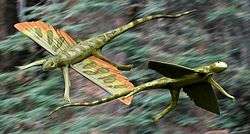Kuehneosaurus
| Kuehneosaurus Temporal range: Late Triassic, Norian | |
|---|---|
 | |
| Life restoration of Kuehneosuchus and Kuehneosaurus (right) | |
| Scientific classification | |
| Kingdom: | Animalia |
| Phylum: | Chordata |
| Class: | Reptilia |
| Family: | †Kuehneosauridae |
| Genus: | †Kuehneosaurus Robinson, 1962 |
| Type species | |
| †Kuehneosaurus latus Robinson, 1962 | |
Kuehneosaurus is an extinct genus of Late Triassic kuehneosaurid reptile known from the Late Triassic (Norian stage) of southwest England. It was named by P. L. Robinson in 1962 and the type and only species is Kuehneosaurus latus. Measuring 72 centimetres long (2.3 feet), it had "wings" formed from ribs which jutted out from its body by as much as 14.3 cm,[1] connected by a membrane which allowed it to slow its descent when jumping from trees. It is a member of a family of gliding reptiles, the Kuehneosauridae, within the larger group Lepidosauromorpha, which also contains modern lizards and tuatara.[2]
Unlike its longer "winged" relative Kuehneosuchus (which may be a species of the same genus or represent a different sexual morph), aerodynamic studies have shown that Kuehneosaurus was probably not a glider, but instead used its elongated ribs to parachute from the trees. A study by Stein et al. in 2008 found that its parachuting speed, descending at a 45-degree angle, would be between 10 and 12 metres per second. Pitch was controlled by lappets (wattle-like flaps of skin) on the hyoid apparatus, as in the modern gliding lizard Draco.[1]
See also
References
- 1 2 Stein, K., Palmer, C., Gill, P.G., and Benton, M.J. (2008). "The aerodynamics of the British Late Triassic Kuehneosauridae." Palaeontology, 51(4): 967-981. doi:10.1111/j.1475-4983.2008.00783.x
- ↑ Evans, S.C. (2003). "At the feet of the dinosaurs: the early history and radiation of lizards." Biological Reviews, 78: 513–551.
- Robinson PL (1962) Gliding lizards from the Upper Keuper of Great Britain. Proceedings of the Geological Society London 1601:137–146.
- Robinson PL (1967a) Triassic vertebrates from upland and lowland. Science and Culture 33:169–173.
- Evans SE, Jones MEH (2010) The Origin, early history and diversification of lepidosauromorph reptiles. In Bandyopadhyay S. (ed.), New Aspects of Mesozoic Biodiversity, 27 Lecture Notes in Earth Sciences 132, 27-44. doi:10.1007/978-3-642-10311-7_2,